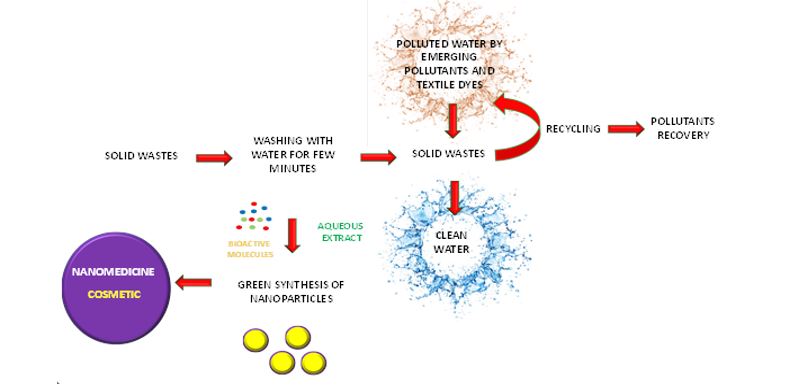Video Article Open Access
Wastes Transformation in Resources for Biomedical, Cosmetic and Environmental Applications
Vito Rizzi1,*, Jennifer Gubitosa1, Paola Fini2, Angela Agostiano1,2, Pinalysa Cosma1,2
1Department of Chemistry, University of Bari, Via Orabona, 4- 70126 Bari, Italy
2Consiglio Nazionale delle Ricerche CNR-IPCF, UOS Bari, Via Orabona, 4- 70126 Bari, Italy
Vid. Proc. Adv. Mater., Volume 3, Article ID 2203258 (2022)
DOI: 10.5185/vpoam.2022.03258
Publication Date (Web): 23 Jul 2022
Copyright © IAAM
Graphical Abstract

Abstract
Each year around 20 % of food produced in the European Union (EU) is wasted get worsening social, environmental, and economic problems. For that reason, EU is trying to solve the problem incentivizing food wastes management for the developments of sustainable paths for innovative recycling approaches. So, the circular economy has become the focus of a recent major EU policy program. In particular, the EU Action Plan for the Circular Economy (European Commission, 2015) lists biomass and bio-based products as interesting resources (outputs) to be up-cycled to “new input products”. On this ground, this work would meet the strategies of H2020 and Horizon-Europe, providing societal benefits in terms of improved health care and quality of life for a sustainable and inclusive growth of society preserving environment. Accordingly, multifunctional, low-cost, and environmentally friendly nanoparticles (NPs) for applications in nanomedicine and cosmetic will be developed, with the ambitious aim to scaling up the laboratory experience to industrial scale demonstrating the large production. [1,2] All the processes would respect the green chemistry and sustainability, with the aim to reduce the whole environmental impact by respecting the European Green Deal and the United Nations Sustainable Development Goals. Specifically, by adopting safe-by-design approaches, contributing towards the framework of EU nanosafety, the food and agricultural wastes, as olive and grape pomace, fruit peels, wasted vegetables and other typical food products of Italy, will be used as source of bioactive molecules for the green synthesis of NPs in water medium. The waste materials will be only washed with water extracting bioactive molecules needed for the synthesis preventing the use of toxic reagents. Moreover, to avoid the disposal of the solid wastes, derived from the pre-treatments with hot water (so, hard and not safe conditions of work will be intrinsically avoided before their use), they would be proposed as recyclable long lasting adsorbents materials to remove emerging contaminants (for the first time) and textiles dyes from water. Mixture of pollutants will be also removed with high efficiencies, and the mechanism of adsorption will be detailed searching the best adsorbent (or more than one) to be used for real applications in presence of industrial effluents. [3,4] The recycling of both the adsorbent and the pollutants will be also attempted by green approaches.
Keywords
Adsorption; green chemistry; bio-circular economy; emerging pollutants; textile dyes.
Acknowledgement
This work was supported by “Research for Innovation (REFIN) per l’individuazione dei progetti di ricerca” – PUGLIA FESR-FSE 2014/2020, Project title: “Incontro tra Ricerca & Impresa per lo Sviluppo Sostenibile del territorio (IRISS): valorizzazione di scarti alimentari per la rimozione di contaminati emergenti dalle acque”, and Dottorati di ricerca in Puglia XXXIII, XXXIV, XXXV ciclo, POR PUGLIA FESR-FSE 2014/2020.
References
- J. Gubitosa, V. Rizzi, A. Lopedota, A. Laurenzana, G. Fibbi, F. Fanelli, A. Petrella, V. Laquintana, N. Denora, R. Comparelli, P. Cosma, Journal of Colloid and Interface Science, 2018, 521, 50.
- J. Gubitosa, V. Rizzi, P. Fini, R. Del Sole, A. Lopedota, V. Laquintana, N. Denora, A. Agostiano, P. Cosma, Materials Science & Engineering C, 2020, 106, 110170.
- V. Rizzi, D. Lacalamita, J. Gubitosa, P. Fini, A. Petrella, R. Romita, A. Agostiano, J.A. Gabaldón, M. I. F.Gorbe, T. Gómez-Morte, P. Cosma, Sci. Total Environ., 2019, 693,133620;
- V. Rizzi, J. Gubitosa, R. Signorile, P. Fini, C. Cecone, A. Matencio, F. Trotta, P. Cosma, (2021) Chem. Eng. J., 2019, 411, 128514.
Biography
Vito Rizzi studied Chemistry at the University of Bari, Department of Chemistry, Italy and graduated as MS in 2012. During his MS, he joined the research group of Prof. Pinalysa Cosma and Angela Agostiano at the same Department. He received his PhD degree in 2016 at the same institution by debating a thesis about the use of multifunctional materials for water remediation and biomedical studies. After three year postdoctoral fellowship, supervised by Prof. Cosma, he obtained the position of Researcher and Assistant Professor. He has published more than 50 research articles in international journals.
Video Proceedings of Advanced Materials

Upcoming Congress



